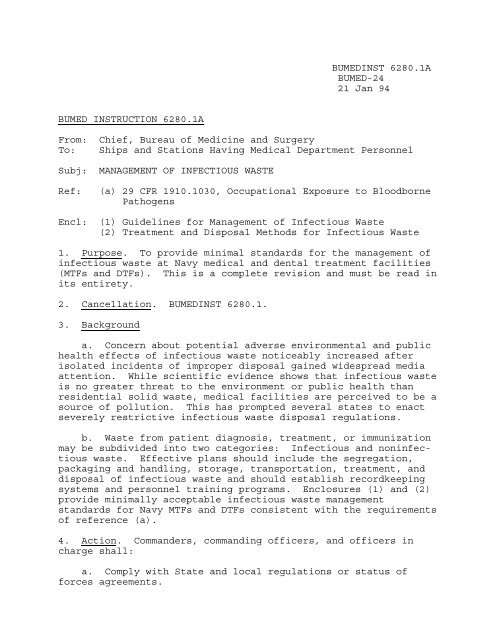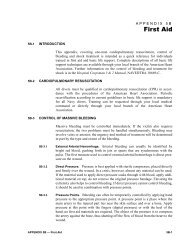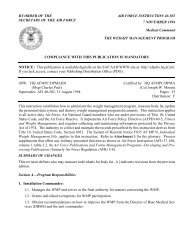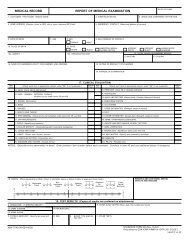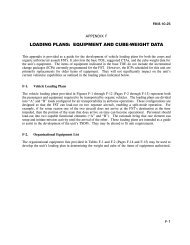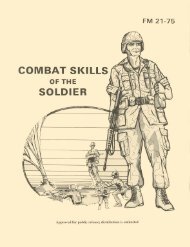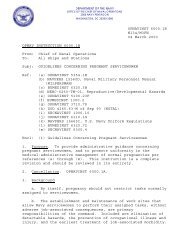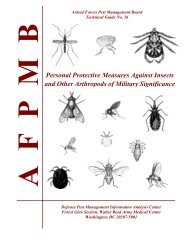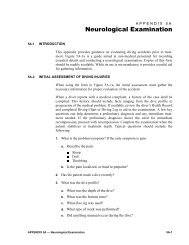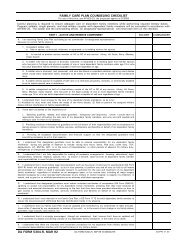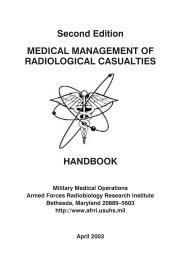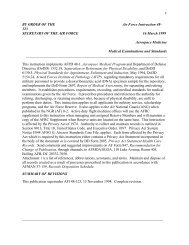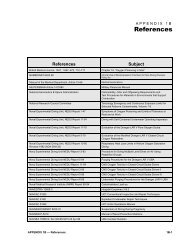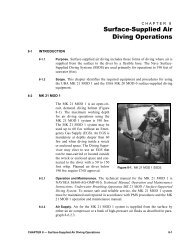BUMED INSTRUCTION 6280.1A Management of Infectious Waste
BUMED INSTRUCTION 6280.1A Management of Infectious Waste
BUMED INSTRUCTION 6280.1A Management of Infectious Waste
Create successful ePaper yourself
Turn your PDF publications into a flip-book with our unique Google optimized e-Paper software.
<strong>BUMED</strong>INST <strong>6280.1A</strong><strong>BUMED</strong>-2421 Jan 94<strong>BUMED</strong> <strong>INSTRUCTION</strong> <strong>6280.1A</strong>From: Chief, Bureau <strong>of</strong> Medicine and SurgeryTo: Ships and Stations Having Medical Department PersonnelSubj: MANAGEMENT OF INFECTIOUS WASTERef:(a) 29 CFR 1910.1030, Occupational Exposure to BloodbornePathogensEncl: (1) Guidelines for <strong>Management</strong> <strong>of</strong> <strong>Infectious</strong> <strong>Waste</strong>(2) Treatment and Disposal Methods for <strong>Infectious</strong> <strong>Waste</strong>1. Purpose. To provide minimal standards for the management <strong>of</strong>infectious waste at Navy medical and dental treatment facilities(MTFs and DTFs). This is a complete revision and must be read inits entirety.2. Cancellation. <strong>BUMED</strong>INST 6280.1.3. Backgrounda. Concern about potential adverse environmental and publichealth effects <strong>of</strong> infectious waste noticeably increased afterisolated incidents <strong>of</strong> improper disposal gained widespread mediaattention. While scientific evidence shows that infectious wasteis no greater threat to the environment or public health thanresidential solid waste, medical facilities are perceived to be asource <strong>of</strong> pollution. This has prompted several states to enactseverely restrictive infectious waste disposal regulations.b. <strong>Waste</strong> from patient diagnosis, treatment, or immunizationmay be subdivided into two categories: <strong>Infectious</strong> and noninfectiouswaste. Effective plans should include the segregation,packaging and handling, storage, transportation, treatment, anddisposal <strong>of</strong> infectious waste and should establish recordkeepingsystems and personnel training programs. Enclosures (1) and (2)provide minimally acceptable infectious waste managementstandards for Navy MTFs and DTFs consistent with the requirements<strong>of</strong> reference (a).4. Action. Commanders, commanding <strong>of</strong>ficers, and <strong>of</strong>ficers incharge shall:a. Comply with State and local regulations or status <strong>of</strong>forces agreements.
<strong>BUMED</strong>INST <strong>6280.1A</strong>21 Jan 94b. Ensure that guidelines in this document are adopted whereState or local regulations are less restrictive or absent.D. F. HAGENStocked:Navy Aviation Supply OfficePublications and Forms Directorate Code 1035801 Tabor AvenuePhiladelphia PA 19120-5099
2<strong>BUMED</strong>INST <strong>6280.1A</strong>21 Jan 94GUIDELINES FOR MANAGEMENT OF INFECTIOUS WASTE1. Introductiona. Exposure to infectious waste that could result in diseaseis more likely to occur in occupational settings that generate,transport, store, treat, or dispose <strong>of</strong> potentially infectiousmaterials. Due to biological instability <strong>of</strong> most micro-organismscommonly regarded as human pathogens, the potential for adverseenvironmental or public health consequences is negligible.b. Due to the perception that the risk from infectious wasteis greater in the occupational setting, the employer must ensurethat such wastes are properly managed on-site and that <strong>of</strong>f-sitetransport and disposal are properly handled. Reference (a)establishes specific requirements for control <strong>of</strong> occupationalexposure to bloodborne pathogens. The guidelines outlined belowestablish infectious waste management standards for Navy MTFs andDTFs consistent with these requirements.2. Noninfectious <strong>Waste</strong>. Items determined to be noninfectiouswaste can be treated as general waste, using accepted methods <strong>of</strong>collection, storage, transport, and disposal. Examples are:a. Used personal hygiene products such as diapers, facialtissues, and sanitary napkins, unless the waste is fromisolation rooms or, in the case <strong>of</strong> sanitary napkins, originatesfrom post partum suites or gynecological surgery wards.b. Absorbent materials, not including waste from isolationrooms, containing very small amounts <strong>of</strong> blood or other bodyfluids.3. <strong>Infectious</strong> <strong>Waste</strong>a. Definition. <strong>Infectious</strong> waste is liquid or solid wastecontaining pathogens in sufficient numbers and <strong>of</strong> sufficientvirulence to cause infectious disease in susceptible hostsexposed to the waste. Examples are:(1) Sharps, including hypodermic needles, syringes,scalpel blades, suture needles, Pasteur pipettes, specimenslides, cover slips, glass petri plates, and broken glasscontaminated with potentially infectious material.
(2) Microbiology wastes from cultures and stockscontaining microbes that, due to their species, type, virulence,or concentration, are known to cause disease in humans. Thisincludes specimens from medical and pathology laboratories,<strong>BUMED</strong>INST <strong>6280.1A</strong>21 Jan 94Enclosure (1)discarded live vaccines, wastes from production <strong>of</strong> biologicals,cultures and stocks <strong>of</strong> infectious agents from clinical researchand industrial laboratories, and disposable culture dishes anddevices used to transfer, inoculate, or mix cultures.(3) Liquid or semi-liquid blood or other potentiallyinfectious body fluids including semen, vaginal secretions,cerebrospinal fluid, pleural fluid, synovial fluid, pericardialfluid, amniotic fluid, saliva in dental procedures, and any bodyfluid visibly contaminated with blood. Also materials thatcould release blood or other potentially infectious body fluidsin a liquid or semi-liquid state if compressed, items cakedwith dried blood, or other potentially infectious body fluids,capable <strong>of</strong> releasing these materials during handling, areclassified as infectious waste.(4) Pathological wastes, including human tissues andorgans, amputated limbs or other body parts, fetuses, placentas,and similar tissues from surgery, delivery, or autopsyprocedures. Animal carcasses, body parts, and bedding exposedto human pathogens are also included in this category.(5) Medical items from isolation rooms contaminated orlikely to be contaminated with blood or other potentiallyinfectious materials.b. Segregation(1) Separate infectious waste from noninfectious waste atits point <strong>of</strong> origin. <strong>Infectious</strong> waste shall be placed incontainers labeled with the universal biohazard symbol and theword "BIOHAZARD" or be red in color. Containers shall be linedwith plastic bags <strong>of</strong> sufficient thickness, durability, punctureresistance, and burst strength to prevent rupture or leaks.(2) Plastic bags should be <strong>of</strong> sufficient quality andthickness so that only one bag is needed for most situations.Bags shall be labeled or color coded per paragraph 3b(1) <strong>of</strong> thisenclosure, and secured before being removed or replaced. Bagsshall never be overloaded.(3) Place sharps into rigid, puncture resistant sharps
containers which are labeled or color coded per paragraph 3b(1)<strong>of</strong> this enclosure. Never clip, cut, bend, or recap needles oroverfill containers. Sharps containers shall be closed beforeremoval or replacement to prevent spillage or protrusion <strong>of</strong>contents during handling, storage, or transport.Enclosure (1) 2<strong>BUMED</strong>INST <strong>6280.1A</strong>21 Jan 94c. Packaging and Handling(1) Sharps containers shall be placed in a secondcontainer (plastic bag or rigid box) which is labeled or coloredcoded per paragraph 3b(1) <strong>of</strong> this enclosure before treatment anddisposal.(2) Minimize human exposure to infectious waste duringtransport to treatment or storage areas. Do not transportinfectious waste in chutes or dumbwaiters.(3) Place all anatomical pathology waste into double-wallcorrugated boxes or equivalent rigid containers that are doublelinedwith plastic bags for transport and incineration in aninfectious waste incinerator. Containers shall be labeled orcolor coded per paragraph 3b(1) <strong>of</strong> this enclosure. Ethicalconsiderations may dictate using alternate means <strong>of</strong> disposal,such as cremation or burial by a licensed mortician. Logisticconstraints may require freezing this material before finaldisposal.(4) Blood and other potentially infectious liquid wastes.(a) Blood, suctioned fluids, or other potentiallyinfectious liquid waste may be decanted into clinical sinks (nothand washing sinks), unless this practice is prohibited by Stateor local regulations. Empty containers shall be treated asinfectious waste.(b) Commercially available absorbent materials whichform a semirigid gel when added to liquids (gelatinization) mayalso be used to solidify blood and other potentially infectiousliquid waste in suction canisters or other containers.Solidified, liquid infectious materials shall be treated asinfectious waste.(c) Bulk blood and other potentially infectiousliquid waste which cannot be safely decanted (e.g., pleurovacs
and hemovacs) or which has not been solidified shall be placedinto rigid containers that are double-lined with plastic bags fortransport and incineration. Containers must be labeled or colorcoded per paragraph 3b(1) <strong>of</strong> this enclosure.(d) Suction canister waste from operating rooms shallbe handled following paragraphs 3c(4)(a), (b), or (c) <strong>of</strong> thisenclosure.(5) Protective apparel or equipment such as gloves,coveralls, mask, and goggles appropriate for the risk levelassociated with a particular task shall be worn. Refer toreference (a) for further guidance.<strong>BUMED</strong>INST <strong>6280.1A</strong>21 Jan 943 Enclosure (1)d. Storage. If infectious waste cannot be treated on-site,the following storage requirements apply:(1) Limit storage without refrigeration to 7 days, exceptin States with stricter requirements. Contact the local healthdepartment for specific information. Keep storage time to aminimum. Consider storage times when contracting for disposal.(2) Store infectious waste in a designated storage arealocated at or near the treatment or transport site.(a) Storage areas shall be constructed to prevententry <strong>of</strong> rodents and other pests and kept clean.(b) The universal biohazard symbol and the word"BIOHAZARD" shall be clearly visible on the outside <strong>of</strong> thestorage area.(c) Limit access to authorized personnel only.e. Transportation(1) Place infectious waste into rigid, leak-pro<strong>of</strong>containers before transporting <strong>of</strong>f-site. Containers shall belabeled or color coded per paragraph 3b(1) <strong>of</strong> this enclosure.(2) Refer to Federal, State, and local laws, regulations,or status <strong>of</strong> forces agreements for transportation requirementssuch as licensing and vehicle labeling.f. Treatment and Disposal(1) <strong>Infectious</strong> waste treatment is achieved throughdestruction, such as by incineration, or through inactivation by
heat, chemicals, or radiation without disintegrating the cells.(2) <strong>Infectious</strong> waste treatment and disposal regulationsare not sufficiently uniform to allow a single treatmenttechnique for all activities. In the absence <strong>of</strong> any Federalregulations about specific treatment methods, activities arerequired to comply with State and local regulations. Enclosure(2) provides generally accepted treatment and disposal methodsfor infectious waste.(3) <strong>Infectious</strong> waste shall be sterilized and renderednoninfectious before compacting or grinding. Bureau <strong>of</strong> Medicineand Surgery (MED-04) approval is required before the purchase orlease <strong>of</strong> an infectious waste treatment system. Any new treatmenttechniques submitted for approval shall be acceptable to localregulating authorities, shall have scientific evidence <strong>of</strong>Enclosure (1) 4<strong>BUMED</strong>INST <strong>6280.1A</strong>21 Jan 94efficacy, and shall have successful use elsewhere for a minimum<strong>of</strong> 2 years.(4) In areas without infectious waste managementregulations, sharps and potentially infectious medical laboratorywaste shall be treated as prescribed in enclosure (2) beforedisposal.g. Manifesting and Recordkeeping(1) Develop a practical system to monitor disposal<strong>of</strong> infectious waste. This system shall include: date, type <strong>of</strong>waste, amount (weight, volume, or number <strong>of</strong> containers), anddisposition.(2) If infectious waste is transported <strong>of</strong>f-site, thereceiving facility shall provide written documentation <strong>of</strong> propertreatment and disposal.h. Training. All employees with occupational exposure toinfectious waste shall receive training at the time <strong>of</strong> initialassignment to tasks and annually, thereafter. Content <strong>of</strong> thetraining is outlined in reference (a). Employees shall receivesupplemental training whenever new procedures or processes areinitiated. All training shall be documented as required byreference (a).i. Safety and Occupational Health. Safety and occupationalhealth requirements for personnel with occupational exposure toinfectious waste are described in reference (a).
4. Cleanup <strong>of</strong> <strong>Infectious</strong> <strong>Waste</strong> Spillsa. <strong>Infectious</strong> waste spills shall be cleaned up immediately.b. Personnel shall wear appropriate protective apparel orequipment, such as gloves, coveralls, mask, and goggles, toprevent exposure to infectious waste when cleaning up spills.c. Place leaking or broken containers in a new, double-linedcontainer. The container shall be labeled or color coded as inparagraph 3b(1) <strong>of</strong> this enclosure. Remove blood and body fluidspills with an absorbent material and disinfect the area with anEnvironmental Protection Agency approved disinfectant or asolution <strong>of</strong> household bleach diluted 1:10 with clear water.5 Enclosure (1)
<strong>BUMED</strong>INST <strong>6280.1A</strong>21 Jan 94
Enclosure (2)
TREATMENT AND DISPOSAL METHODS FOR INFECTIOUS WASTETypes <strong>of</strong><strong>Infectious</strong> <strong>Waste</strong> Methods <strong>of</strong> Treatment Methods <strong>of</strong> DisposalMicrobiological Steam Sterilization 1 Sanitary LandfillChemical Disinfection 2Incineration 3Pathological 5 Incineration 3 & 4 Sanitary LandfillCremation Burial 6Bulk Blood and Gelatinization 6 Sanitary Sewer 7Other Potentially Sanitary Landfill 8<strong>Infectious</strong>LiquidsSharps in Sharps Steam Sterilization Sanitary LandfillContainers Incineration Sanitary Landfill1For effective sterilization, the temperature must bemaintained at 121 o C (250 o F) for at least 90 minutes, at 15pounds per square inch <strong>of</strong> gauge pressure. Bacillus stearothermophilusspore strips must be used weekly to test thesterilization process.2Chemical disinfection is most appropriate for liquids.3Ash remaining after incineration may go directly to thesanitary landfill, unless State or local regulations requiretesting the ash for characteristics <strong>of</strong> hazardous waste.4Disposal <strong>of</strong> placentas by grinding with subsequent dischargeto a sanitary sewer is acceptable, unless prohibited bycounty or local laws or regulations.5Burial or cremation is acceptable.6Must be further treated by steam sterilization orincineration.7Discharge to a sanitary sewer is acceptable, unlessprohibited by county or local laws or regulations.8Must be treated by steam sterilization or incinerationbefore landfill disposal.


